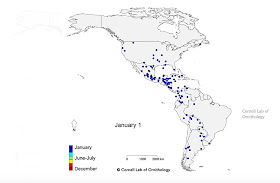by Becky Swearingin MN
About the time I think that bird photography is over until the spring migrations, I find some new raptors that wish to be photographed.
I was in St. Louis during the last weekend of January at a dog show and since I was done at about 10 a.m. at the show I randomly chose a conservation area to visit. The one I chose was Leach Memorial Conservation Area, just north of St. Louis outside of the town of the town of Elsberry. I explored a bit, looking at the river and the remains of the flooding, watching a Kestrel hunt and the waterfowl on the many ponds. After sitting and watching two Savannah Sparrows for a while I decided to go to a different conservation area as nothing seemed to be happening. As I drove down the main road, this landed in front on me on the road.

Of course, what went through my mind was “What the heck, I think that’s an owl!” As I was watching and photographing this owl, I noticed a group of people down the road with scopes and binoculars watching something. Suddenly a second owl flew right by the group. The one I was watching flew off the road and landed on a small tree nearby.

This owl is one of our winter visitors, a Short-Eared Owl. These smallish owls breed in the northern U.S. and Canada. They are fairly abundant and have populations throughout North and South America and Hawaii. Missouri is one of their winter territories. While they hunt day and night, I have found in the population in Dade County that they come out closer to dusk. These owls were active starting at about 3:15 giving me plenty of photographic opportunities. There were three or four that hunted all around the people watching, often landing on small tree right be the road or flying next to the observers. I found the flight shots challenging, but got a couple.

After driving to some other areas in the conservation area I returned to watch the owls one more time. This one seemed to want its picture taken.

The first Saturday of February, I headed to one of my favorite prairies outside of Lockwood in Dade County. When I’ve been there in the late afternoon I have found that there are areas active with Harriers, Hawks, and Falcons. I was hoping to get a picture of another winter visitor, a Merlin. I found a likely spot by Pennsylvania Prairie and waited (and waited and waited) but nothing was happening. I decided to turn around to check out Niawathe Prairie only to discover that right behind my car on a fence post was this lovely Merlin.

I took several shots and crept closer, stopping to take pictures until I was right beside the Merlin on the road. It seemed to be as interested in me as I was in it.

The Merlin is another winter visitor to Missouri. This small raptor, like the Short-Eared Owl, breeds in the north (Canada) but spends its winters in southern states, including Missouri, and Central America. Not much larger than a Kestrel, these raptors are a bit stockier. Their primary prey is songbirds which they catch in midair, a hunting technique I have yet to observe. One of the birds they like to prey on is one of our more common invasive bird species, the House Sparrow, because of this they are becoming more common in urban areas.*
Keep your eyes open for those “snowbirds” who come south for the winter.
Editor's note:
The attack on the House Sparrow (HOSP) is especially welcome for those of us who maintain bluebird boxes on trails. Bluebirds were a threatened species with declining populations from 1920-1970. In 1978 the North American Bluebird Society (NABS) was formed and with bluebird trails and nest boxes, bluebirds are coming back with our help. HOSP are major threats to bluebird populations as seen in these graphic photographs. They are one of the most wide spread species on the planet, well adapted to cities where they can be a major annoyance.
 While we were out surveying for salamanders with Brian Edmond, his net brought up this bug. It is a member of the genus Belostoma, which are referred to as Giant Water Bugs. Other names are electric light bugs for their attraction to lights and "toe biters" which I will leave to your imagination.
While we were out surveying for salamanders with Brian Edmond, his net brought up this bug. It is a member of the genus Belostoma, which are referred to as Giant Water Bugs. Other names are electric light bugs for their attraction to lights and "toe biters" which I will leave to your imagination.

































